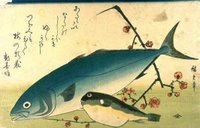
Next week, the
New Horizons mission to Pluto is due to take off. On its journey to the ninth planet one would imagine that the folks at NASA will find out lots about the tens of thousands of icy objects way out in the Kuiper belt, including that Pluto is just one of many similar-sized objects out there. Along with the recently discovered UB313, might there be hundreds of objects discovered that are the size of Pluto?
All this raises the question, once again, of what exactly is a planet. Last year, the discovery of UB313 caused astronomers to rush off to decide, once and for all, what the difference is between a planet and a not-planet. This was reported in Nature in August last year (
see here). They might, says the report, decide in a week. Five months later, I decided to ring up the astronomers for a progress report.
There organisation responsible for deciding what a planet is is the International Astronomical Union, and all the head-honcho astronomers are to be found in orbit around it. One of its vice presidents explained, sorrowfully, that it all turned out to be a bit problematic.
So I called the man who headed the committee. (Remember, these are the guys at college who did double maths and physics because it was easy.) So it came to pass that I chatted with Iwan Williams, a charming astronomer at Queen Mary College. The board, he said, produced some recommendations, he said, but couldn’t decide what the definition of a planet was.
It turned out to be a difficult problem, he said. How hard could it be? I asked in amazement. Well, he said, the only thing the astronomers could agree on was that there is a difference between things that are able to hold themselves together and be spherical under the weight of their own gravity and other lumpy objects such as an asteroid and the nucleus of a comet. I wasn’t impressed with progress on the planet/not-planet issue. OK, I say, so what’s the problem defining a planet as something where gravity makes the object spherical? The problem, he replied, is that if you use this definition you get too many planets.
“Too many planets!” I exclaimed, “how many is too many?”
“Well, about 30” he said sheepishly.
“But who are you to say what the right number of planets are in the solar system?”
It turns out that astronomers quite like there being a small number of planets, it makes them special. Planetary astronomers particularly, one presumes, have a sense of superiority over their co-workers who study mere asteroids and minor moons. And it might upset the public, as well, which has gotten used to this nice nine-planet solar system. The Earth seems so much special as one of nine. But one of 30?
So later this year, at a big IAU punch up, I meet conference, in Prague, they'll have to decide. Sounds like somehow they'll make sure that we all get the "correct" number of planets that we've come to expect rather than anything that would disturb today's vision of the universe. So much for paradigm shifts and scientific revolutions. Crikey, Copernicus will be turning in his grave.
Latest: one reader writes to suggest Pluto be renamed: "the object formerly known as Pluto"Postcards from the edgeJan 12th 2006
From The Economist print edition
A greater understanding of the Kuiper belt will fuel uncertainty over what, exactly, a planet isONCE upon a time, people thought that the solar system consisted of four small, rocky inner planets, four large, gassy outer planets and an odd little runt called Pluto. Since the early 1990s, though, almost a thousand other runts have been discovered in the region of the solar system called the Kuiper belt, where Pluto resides. Most of these objects are a lot smaller than Pluto, but a few are of similar size and one called 2003 UB313 is larger. (
More... no sub req)
 Lot 195, on sale at London auctioneer Bonhams earlier this week: Apollo 11 moon dust. Now you don't see that every day. When I called Bonham's to ask where it came from, the press officer said, "the moon".
Lot 195, on sale at London auctioneer Bonhams earlier this week: Apollo 11 moon dust. Now you don't see that every day. When I called Bonham's to ask where it came from, the press officer said, "the moon".
